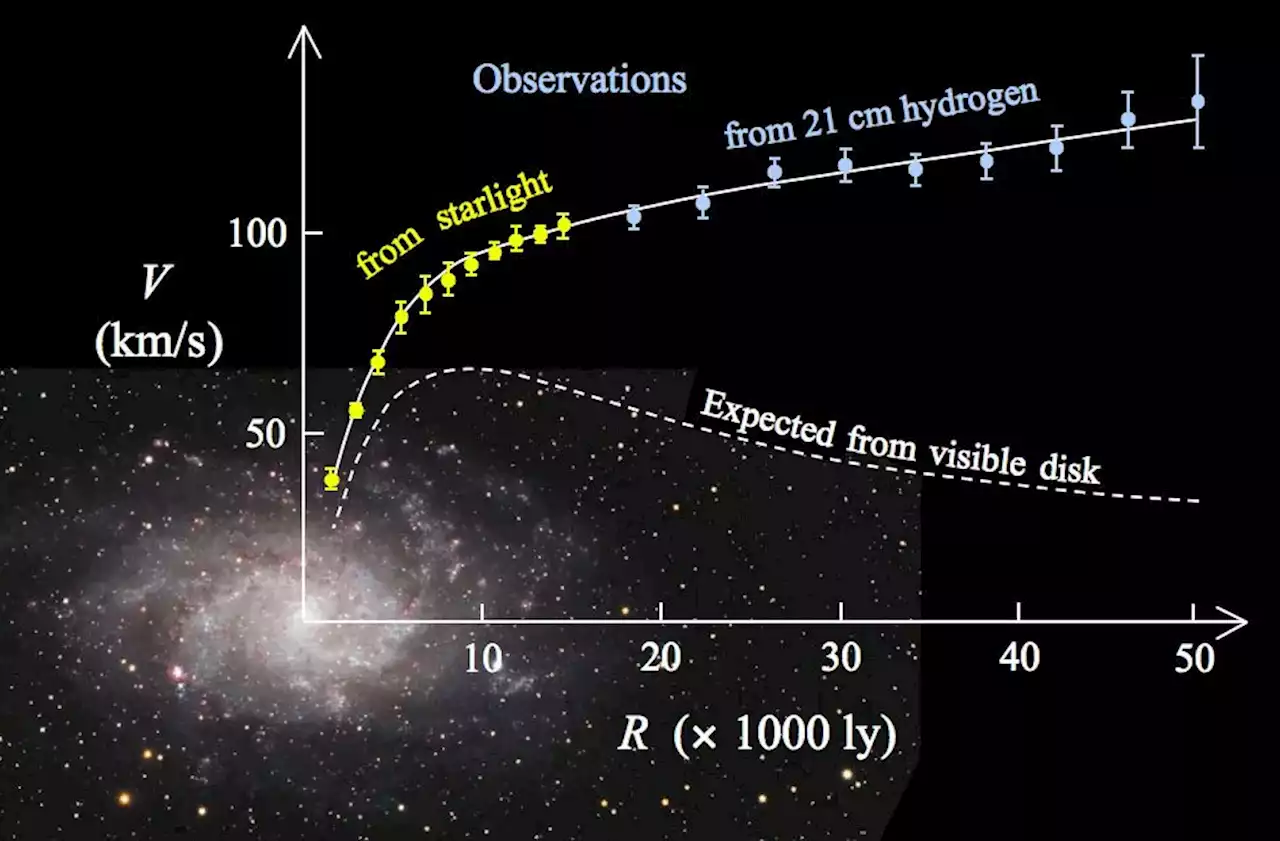New Measurements of Galaxy Rotation Lean Towards Modified Gravity as an Explanation for Dark Matter - by BrianKoberlein
Although dark matter is a central part of the standard cosmological model, it’s not without its issues. There continue to be nagging mysteries about the stuff, not the least of which is the fact that scientists have found no direct particle evidence of it. Despite numerous searches, we have yet to detect dark matter particles. So some astronomers favor an alternative, such as Modified Newtonian Dynamics or modified gravity model. And a new study of galactic rotation seems to support them.
The idea of MoND was inspired by galactic rotation. Most of the visible matter in a galaxy is clustered in the middle, so you’d expect that stars closer to the center would have faster orbital speeds than stars farther away, similar to the planets of our solar system. What we observe is that stars in a galaxy all rotate at about the same speed. The rotation curve is essentially flat rather than dropping off.
Rotation curve of the typical spiral galaxy M 33 and the predicted one from distribution of the visible matter . The discrepancy between the two curves is accounted for by adding a dark matter halo surrounding the galaxy. Credit: Public domain / Wikipedia At interstellar distances, the gravitational attraction between stars is essentially Newtonian. So rather than modifying general relativity, Milgrom proposed modifying Newton’s Universal Law of Gravity. He argued that rather than the force of attraction is a pure inverse square relation, gravity has a small remnant pull regardless of distance. This remnant is only about 10 trillionths of a gee, but it’s enough to explain galactic rotation curves.
Australia Latest News, Australia Headlines
Similar News:You can also read news stories similar to this one that we have collected from other news sources.
 Nathan Eovaldi signing $34 million contract with RangersJacob deGrom’s new rotation just got another boost.
Nathan Eovaldi signing $34 million contract with RangersJacob deGrom’s new rotation just got another boost.
Read more »
 Multitasking powerhouse Galaxy Z Fold 3 is an eye-popping $860 off in no strings dealSamsung's last year's Galaxy Z Fold 3 hits a new Amazon low.
Multitasking powerhouse Galaxy Z Fold 3 is an eye-popping $860 off in no strings dealSamsung's last year's Galaxy Z Fold 3 hits a new Amazon low.
Read more »
 Prolific leaker expects new type of zoom camera on the Samsung Galaxy S24Ice Universe is back at it again with the ever-increasing camera expectations for Samsung's future camera phones.
Prolific leaker expects new type of zoom camera on the Samsung Galaxy S24Ice Universe is back at it again with the ever-increasing camera expectations for Samsung's future camera phones.
Read more »
 New Galaxy S23 leak teases massive performance gains over S22According to a leaker, the Galaxy S23 should deliver remarkable performance gains over the Galaxy S22 - what you need to know.
New Galaxy S23 leak teases massive performance gains over S22According to a leaker, the Galaxy S23 should deliver remarkable performance gains over the Galaxy S22 - what you need to know.
Read more »
 Rangers sign Nathan Eovaldi to multi-year deal, providing rotation depth, flexibilityWhen you ask Chris Young about a pitching move – something that has been seemingly a weekly occurrence this offseason – he will tilt his head slightly, offer...
Rangers sign Nathan Eovaldi to multi-year deal, providing rotation depth, flexibilityWhen you ask Chris Young about a pitching move – something that has been seemingly a weekly occurrence this offseason – he will tilt his head slightly, offer...
Read more »
 Radiant Blue Swirls: Hubble Captures Majestic Barred Spiral GalaxyAgainst an inky black backdrop, the blue swirls of spiral galaxy NGC 6956 stand out radiantly. NGC 6956 is a barred spiral galaxy, a common type of spiral galaxy with a bar-shaped structure of stars in its center. This galaxy exists 214 million light-years away in the constellation Delphinus. Sci
Radiant Blue Swirls: Hubble Captures Majestic Barred Spiral GalaxyAgainst an inky black backdrop, the blue swirls of spiral galaxy NGC 6956 stand out radiantly. NGC 6956 is a barred spiral galaxy, a common type of spiral galaxy with a bar-shaped structure of stars in its center. This galaxy exists 214 million light-years away in the constellation Delphinus. Sci
Read more »
